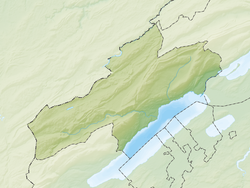
Back Le Locle ALS لو لوكل (سويسرا) Arabic Le Locle Breton Le Locle Catalan Le Locle (munisipyo) CEB Le Locle Czech Ле-Локль CV Le Locle Danish Le Locle German Λε Λοκλ Greek
Le Locle | |
|---|---|
 | |
| Coordinates: 47°03′11″N 6°44′53″E / 47.05317°N 6.74816°E | |
| Country | Switzerland |
| Canton | Neuchâtel |
| Government | |
| • Executive | Conseil communal with 5 members |
| • Mayor | Président du Conseil communal (list) Denis de la Reussille (as of March 2014) |
| • Parliament | Conseil général with 41 members |
| Area | |
| • Total | 23.14 km2 (8.93 sq mi) |
| Elevation | 945 m (3,100 ft) |
| Population (31 December 2018)[2] | |
| • Total | 10,216 |
| • Density | 440/km2 (1,100/sq mi) |
| Time zone | UTC+01:00 (Central European Time) |
| • Summer (DST) | UTC+02:00 (Central European Summer Time) |
| Postal code(s) | 2400 |
| SFOS number | 6436 |
| ISO 3166 code | CH-NE |
| Surrounded by | La Chaux-de-Fonds, La Chaux-du-Milieu, La Sagne, Le Cerneux-Péquignot, Les Brenets, Les Planchettes, Les Ponts-de-Martel, Villers-le-Lac (FR-25) |
| Website | www SFSO statistics |
| UNESCO World Heritage Site | |
|---|---|
| Part of | La Chaux-de-Fonds / Le Locle, Watchmaking Town Planning |
| Criteria | Cultural: (iv) |
| Reference | 1302-002 |
| Inscription | 2009 (33rd Session) |
| Area | 70.2 ha (173 acres) |
| Buffer zone | 1,620.2 ha (4,004 acres) |
Le Locle (French pronunciation: [lə lɔkl]; German: Luggli) is a municipality in the Canton of Neuchâtel in Switzerland.
It is situated in the Jura Mountains, a few kilometers from the city of La Chaux-de-Fonds. It is the third smallest city in Switzerland (in Switzerland a place needs more than 10,000 inhabitants to be considered a city).
Le Locle is known as a center of Swiss watchmaking, even cited as the birthplace of the industry, with roots dating back to the 1600s.[3] The municipality has been home to manufactures such as Favre-Leuba, Mido, Zodiac, Tissot, Ulysse Nardin, Zenith, Montblanc, Certina as well as Universal Genève, before the latter company relocated to Geneva. The town's history in watchmaking is documented at one of the world's premier horological museums, the Musée d'Horlogerie du Locle, Monts Castle, located in a 19th-century country manor on a hill north of the city.[4] Restored historic underground mills (grainmill, oilmill, sawmill) can be seen in a cave located about one kilometer (0.6 miles) west of the city center.[5]
The name of the town derives from the word for lake or trou d'eau.
- ^ a b "Arealstatistik Standard - Gemeinden nach 4 Hauptbereichen". Federal Statistical Office. Retrieved 13 January 2019.
- ^ "Ständige Wohnbevölkerung nach Staatsangehörigkeitskategorie Geschlecht und Gemeinde; Provisorische Jahresergebnisse; 2018". Federal Statistical Office. 9 April 2019. Retrieved 11 April 2019.
- ^ Teller, Matthew (May 17, 2010). The Rough Guide to Switzerland. Rough Guides. ISBN 978-1-84836-471-4.
- ^ Watchmaking museum Archived 2008-06-18 at the Wayback Machine (in French)
- ^ Underground mill at Col des Roches (in French)
© MMXXIII Rich X Search. We shall prevail. All rights reserved. Rich X Search




